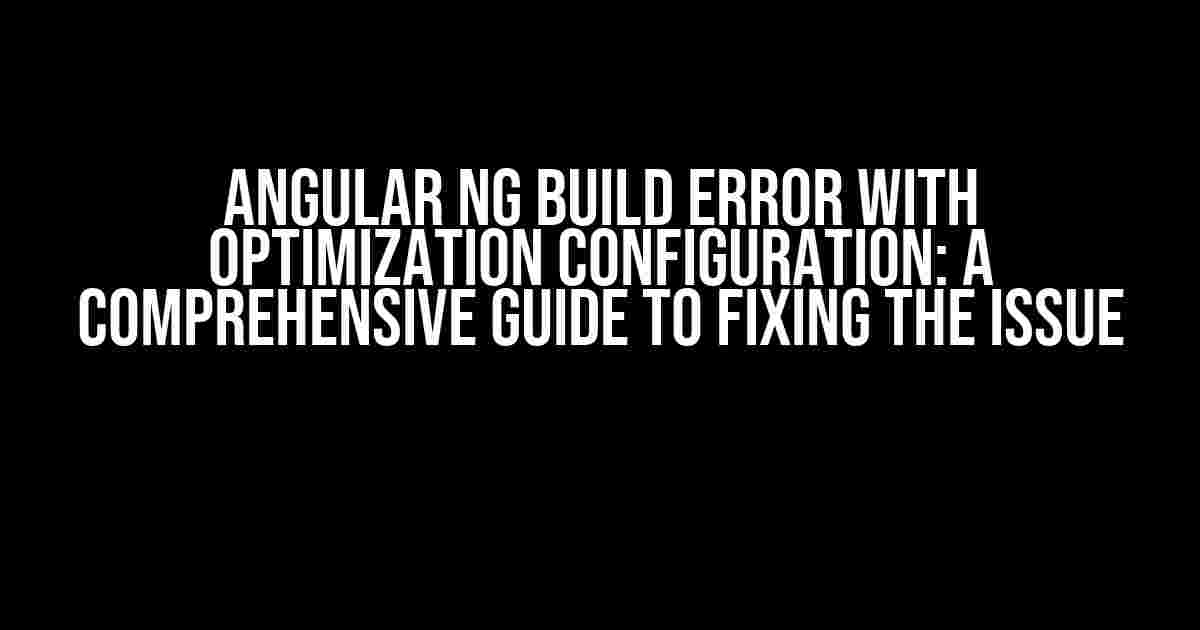Are you tired of encountering errors when running the ng build command with optimization configuration in your Angular project? You’re not alone! This frustrating issue can hinder your development process and leave you scratching your head. Fear not, dear developer, for we’re about to dive into the world of optimization errors and explore the solutions to get your project building smoothly again.
What is optimization configuration in Angular?
In Angular, optimization configuration refers to the process of minimizing and compressing your application’s code to improve its performance. This is achieved through the use of various plugins and tools, such as UglifyJS and Rollup, which reduce the file size and complexity of your code. Optimization is crucial for production-ready applications, as it enhances user experience and reduces loading times.
The ng build error with optimization configuration
The error typically manifests itself when you run the ng build --prod command, which enables optimization by default. The error message may vary, but it usually includes information about a specific plugin or module causing the issue. For example:
ERROR in Error: UnglifyJS failed to minify ./node_modules/@angular/core/fesm2015/core.mjs
This error can be attributed to a range of factors, including:
- Incompatible plugin versions
- Incorrect configuration settings
- Dependency issues
- Module conflicts
Step-by-Step Solution to Fix the ng build Error with Optimization Configuration
Don’t worry; we’ve got you covered! Follow these steps to resolve the ng build error with optimization configuration:
-
Update Angular CLI and Dependencies
Ensure you’re running the latest version of Angular CLI and its dependencies. Run the following command:
ng update @angular/cli @angular/core -
Check plugin versions
Verify that your plugin versions are compatible with each other. You can do this by running:
ng config Cli.pluginsThis will display a list of plugins and their versions. Check for any inconsistencies or outdated versions.
-
Disable optimization temporarily
Try building your project without optimization to isolate the issue. Run:
ng build --prod --optimization=falseIf the build succeeds, it indicates that the error is related to the optimization configuration.
-
Configure optimization settings
In your
angular.jsonfile, locate theoptimizationsection and adjust the settings accordingly. You can disable specific plugins or change the optimization level:"optimization": { "scripts": true, "styles": { "minify": true }, "ecmaFeatures": { "enabled": true }, "fonts": true, "images": true } -
Exclude problematic modules
If you’ve identified a specific module causing the issue, you can exclude it from the optimization process. Add the module to the
optimization.excludearray:"optimization": { "exclude": ["@angular/core"] } -
Delete node_modules and reinstall dependencies
In some cases, deleting the
node_modulesdirectory and reinstalling dependencies can resolve the issue. Run:rm -rf node_modules && npm install -
Check for module conflicts
If you’ve recently added a new module, it might be conflicting with an existing one. Review your module imports and dependencies to ensure they’re compatible.
-
Rebuild your project
Once you’ve applied the above steps, rebuild your project using:
ng build --prod
Common Errors and Solutions
Here are some common errors you might encounter during the optimization process, along with their solutions:
| Error | Solution |
|---|---|
| ERROR in Error: Cannot find module ‘tslib’ | Run npm install tslib to install the missing dependency. |
| ERROR in Error: UnglifyJS failed to minify | Check your UglifyJS version and ensure it’s compatible with your Angular version. |
| ERROR in Error: Rollup failed to compile | Verify that your Rollup configuration is correct and that you’ve installed the required plugins. |
Conclusion
In conclusion, the ng build error with optimization configuration can be a frustrating issue, but it’s not insurmountable. By following the step-by-step solution and understanding the common errors and solutions, you’ll be able to resolve the issue and get your project building smoothly again. Remember to stay calm, debug methodically, and don’t hesitate to seek help from the Angular community if needed.
Happy coding, and may the optimization force be with you!
Here are 5 Questions and Answers about “Angular ng build error with optimization configuration”:
Frequently Asked Question
Having trouble with your Angular build? Don’t worry, we’ve got you covered! Here are some answers to common questions about Angular ng build errors with optimization configuration.
What causes the ng build error with optimization configuration?
The ng build error with optimization configuration is often caused by incorrect or outdated configuration settings, incompatible dependencies, or conflicts with other build tools. It can also occur when there are issues with the Angular project structure or when the optimization configuration is not properly defined.
How do I troubleshoot the ng build error with optimization configuration?
To troubleshoot the error, first, check the Angular CLI version and ensure it’s up-to-date. Then, verify that the optimization configuration is properly defined in the angular.json file. Check the console output for any error messages and debug the build process by adding the –verbose flag to the ng build command. Finally, try building the project in a different environment or with a clean cache.
Can I disable optimization for a specific component or module?
Yes, you can disable optimization for a specific component or module by adding the “optimization”: false property to the component or module’s metadata. This will prevent the optimizer from processing that specific component or module, allowing you to isolate and troubleshoot the issue.
What are some common optimization configuration errors to watch out for?
Common optimization configuration errors to watch out for include incorrect optimization levels, missing or invalid optimization configuration, and conflicts with other build tools or plugins. Additionally, be cautious when using custom optimizers or plugins, as they may not be compatible with your project.
How do I optimize my Angular project for production?
To optimize your Angular project for production, use the ng build command with the –prod flag, which enables production mode. You can also customize the optimization configuration by adding settings to the angular.json file. Additionally, consider using a build tool like Webpack to further optimize your project.
Let me know if you need anything else!
